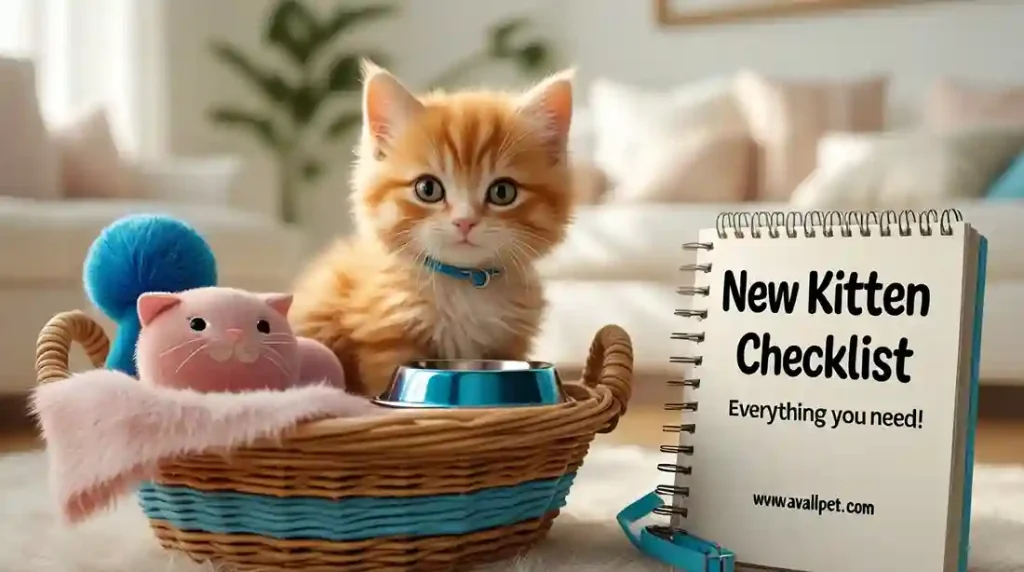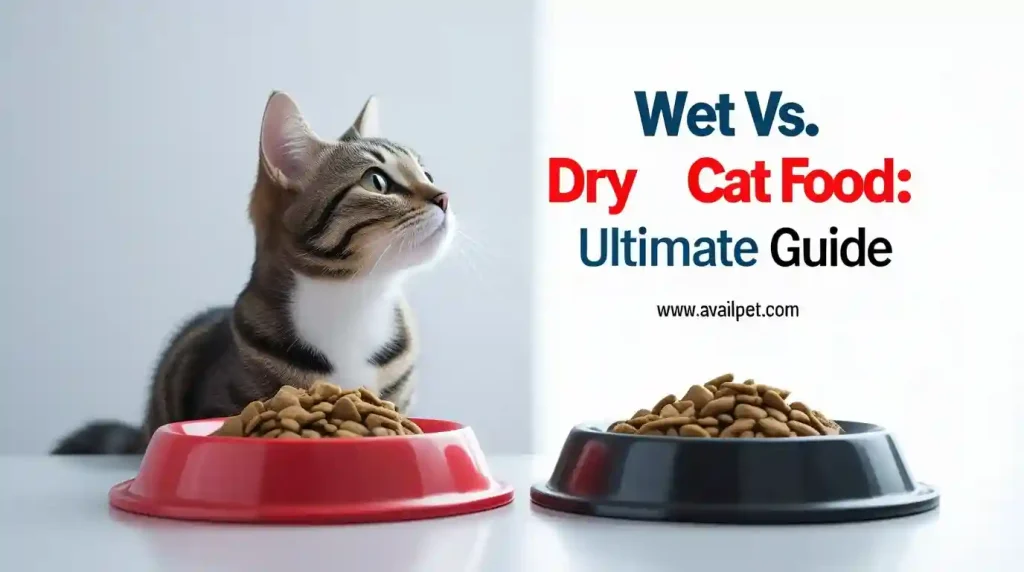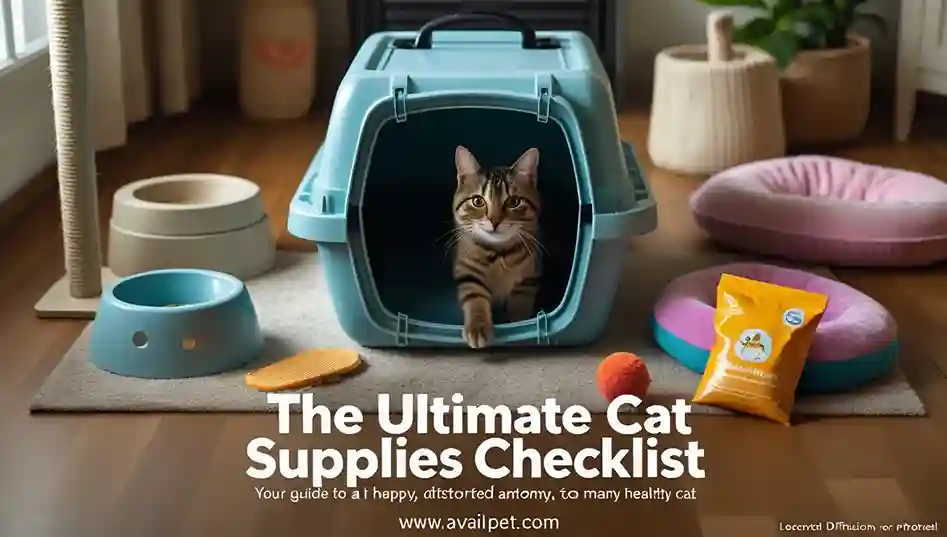That faint, unwelcome odor wafting from the litter box is more than just a nuisance—it’s a clear signal that your cleaning schedule might be out of sync with your cat’s needs. While scooping daily is a great start, the question of when to do a full litter change is where many pet parents get stuck. Getting it wrong can lead to a smelly home and, more importantly, a cat who starts voting with their paws by avoiding the box altogether.
The truth is, there’s no universal answer. The perfect schedule depends on the type of litter you use, how many cats you have, and even their health.
At AvailPet, we’ve cut through the confusion. This definitive guide on how often to change cat litter provides a clear, vet-reviewed schedule for every situation. By following our straightforward advice, you can eliminate guesswork, control odors effectively, and ensure your feline friend always has a clean and inviting place to go. For a deeper dive into choosing the right substrate, explore our comprehensive Cat Litter Guide.
Key Takeaways: How Often to Change Cat Litter
Before we dive into the detailed schedules, here are the most critical, actionable insights from our research and veterinary consultation:
- ⏰ The Golden Rule: Scoop solid waste out of the box every single day. This is the most critical step for immediate odor control and ensuring your cat will want to use the box.
- 🔄 Clumping Litter Schedule: Perform a deep clean of the entire box and replace all litter every 2 to 4 weeks.
- 🚫 Non-Clumping Litter Schedule: Completely replace all litter every 2 to 3 days, as it cannot isolate urine.
- 🐈⬛ The Multi-Cat Rule: If you have two or more cats, you will likely need to change clumping litter every 1 to 2 weeks to stay ahead of the waste.
- 👃 Trust Your Senses: If you can smell the litter box from a few feet away during normal daily activity, it is past due for a change. Your nose is a reliable guide.
Quick-Answer Table: Cat Litter Change Schedule
For a quick, at-a-glance guide, use this vet-reviewed schedule. The detailed explanations follow in the sections below.
| Situation | Scoop Solid Waste | Top Up Litter | Deep Clean & Full Change |
|---|---|---|---|
| Clumping Litter | Daily | As needed to maintain 2-3 inch depth | Every 2-4 weeks |
| Non-Clumping Litter | Daily | N/A | Every 2-3 days |
| Silica Gel Crystals | Daily | N/A | Every 3-4 weeks |
| 2 or More Cats | Twice Daily | Weekly | Every 1-2 weeks |
| Senior Cat or Kitten | Daily | As needed | Every 1-3 weeks (Adjust based on health/usage) |
Pro Tip: For the best-performing clumping litters that make this schedule easy to follow, see our dedicated reviews in the Best Clumping Cat Litter guide.
The Science Behind Your Litter Schedule
Understanding why these schedules matter goes beyond simple cleanliness. The health of your cat and your household can be directly impacted by the frequency of your litter changes.
1. Ammonia Buildup: An Invisible Irritant
When cat urine breaks down, it releases ammonia gas. In a poorly ventilated or infrequently cleaned litter box, these fumes can accumulate. For cats, this can cause respiratory irritation, watery eyes, and exacerbate conditions like asthma. For humans, it can create an unpleasant living environment and trigger allergies.
2. Bacterial Growth: A Hidden Hazard
A litter box is a warm, moist environment—the perfect breeding ground for bacteria like E. coli and Salmonella. These pathogens can pose risks to both feline and human family members, especially if a cat gets waste on its paws and then licks them clean. Regular removal of waste and full litter changes disrupt this bacterial life cycle.
3. Feline Sensitivity: A Matter of Instinct
A cat’s sense of smell is about 14 times stronger than a human’s. What seems “a little off” to you can be overwhelmingly repulsive to them. A dirty box isn’t just an inconvenience; it’s a direct violation of their instinct to bury waste to avoid attracting predators. This is why a clean box is fundamental to preventing litter box aversion, a common issue explored in our Cat Litter Guide.
Factor-by-Factor Change Guide
The “perfect” schedule depends on your specific situation. Use this detailed breakdown to customize the approach for your home.
1. Litter Type is Your #1 Factor
- Clumping Litter: This type is designed to “seal and remove” waste. The clumps trap moisture and odor, which you scoop out daily. This system allows the remaining clean litter to last for 2-4 weeks before a full change is needed.
- Non-Clumping Litter: This litter works by “saturating and absorbing.” The urine spreads throughout the entire box, meaning there’s no way to remove just the soiled parts. To prevent a soggy, smelly box, a complete replacement every 2-3 days is necessary.
- Silica Gel Crystals: These litters “absorb and evaporate” moisture. The crystals lock in urine and allow the water to evaporate over time, while you scoop solids daily. This makes them long-lasting, typically needing a full change only every 3-4 weeks.
- Natural Plant-Based Litters: Performance varies widely by material (corn, wood, paper). Always check the manufacturer’s guidelines, but most require a full change every 2-3 weeks.
2. Household Population: The Math of Multiple Cats
- Single Cat: The standard schedules above apply perfectly.
- Multiple Cats: Double the trouble means doubling your efforts. With two or more cats, you should scoop at least twice daily and plan for a full change of clumping litter every 1-2 weeks. Following the “N+1 rule” (one box per cat, plus one extra) is crucial to distribute the load and prevent accidents.
- Kitten Considerations: While they produce less waste, establishing good hygiene early is key. Stick to a frequent schedule to encourage consistent litter box use during training.
3. Health & Life Stage: Special Considerations
- Senior Cats: Older cats may have medical issues (like kidney disease) that cause them to urinate more frequently and in larger volumes. This will soil the litter faster, potentially requiring more frequent full changes.
- Medical Conditions: Cats with diabetes or kidney disease produce dilute urine in high volumes, quickly overwhelming the litter’s absorbency. You may need to change the litter weekly, even in a single-cat home.
- Post-Surgery Recovery: A sterile environment is critical. Use dust-free litter like paper or a similar recommended option and change it frequently to prevent infection.
4. Environmental Factors You Can Control
- Humidity & Temperature: High humidity can cause litter to clump prematurely or reduce the effectiveness of silica crystals. In damp climates, you may need to change litter more often.
- Ventilation: A well-ventilated area helps control odor and moisture evaporation. A box in a small, enclosed bathroom will need more frequent attention than one in a large, airy basement.
- Litter Box Type: Covered boxes can concentrate odors inside, which may deter a sensitive cat. If you use a hooded box, be extra vigilant about scooping and changing.
Step-by-Step: The Perfect Litter Box Deep Clean
A simple dump-and-refill isn’t enough. Follow this vet-recommended process during each full litter change to eliminate odors and bacteria at the source.
1. Empty & Scrape Completely
Dump all the old litter into a trash bag. Use a dedicated litter scoop or a paper towel to scrape away any stuck-on residue from the bottom and sides of the box.
2. Wash with the Right Cleaners
- Best Choice: Use a mild, unscented dish soap and warm water. This effectively cleans without leaving harsh chemical residues that could deter your cat.
- Good Alternative: A 50/50 solution of white vinegar and water helps neutralize stubborn ammonia odors.
- What to Avoid: Steer clear of bleach, ammonia-based cleaners, or heavily perfumed products. These can be harmful to cats and may leave a scent that repels them from the box.
3. Dry Thoroughly
This is a critical, often missed step. Wipe the box completely dry with paper towels or an old cloth. A damp box can cause litter to clump to the bottom and promote mold and bacterial growth.
4. Refresh with the Right Amount
Pour in a fresh layer of litter, aiming for a depth of 2-3 inches. This is the ideal depth for a cat to dig and for clumping litter to form properly.
Pro Tip: The Box Rotation System
If you have the space, keep a spare, clean litter box on hand. While one box is air-drying after cleaning, you can immediately place the spare one for your cat to use. This prevents “emergencies” and makes the cleaning process less rushed.
Troubleshooting Common Problems
Even with a good schedule, issues can arise. Here are solutions to the most common litter change dilemmas.
Problem: “My litter box smells almost immediately after I change it!”
- Solution 1: You may not be using enough litter. Ensure you have a 2-3 inch depth to allow for proper clumping and absorption.
- Solution 2: The litter itself may be low-quality. Consider upgrading to a high-performance clumping litter with better odor-control ingredients. Our reviews of the Best Clumping Cat Litters can help.
- Solution 3: The litter box itself may be porous and holding onto odors. A thorough deep clean (as outlined above) or replacing an old, scratched plastic box may be necessary.
Problem: “My cat seems to avoid a freshly cleaned box.”
- Solution: Some cats are unsettled by the complete loss of their scent. Try leaving a small amount of the old, clean litter (about a handful) on top of the new litter when you do a full change. This retains a familiar scent marker.
Problem: “I feel like I’m going through litter too quickly.”
- Solution 1: Ensure your litter box is the correct size. An excessively large box requires more litter to achieve the proper depth.
- Solution 2: You might be over-scooping. With clumping litter, you only need to remove the waste clumps, not the surrounding clean litter.
- Solution 3: You may be using a litter that doesn’t last. Litters with poor clump integrity can fall apart, forcing you to remove more material than necessary.
FAQs: How Often to Change Cat Litter
What are the health risks of not changing cat litter often enough?
Infrequent changes can lead to a buildup of ammonia fumes from urine, which can irritate the respiratory tracts of both cats and humans. A dirty box also becomes a breeding ground for bacteria like E. coli and parasites, increasing the risk of urinary tract infections (UTIs) and other illnesses, especially if your cat has a compromised immune system.
Can switching my cat’s litter brand too often cause problems?
Yes, frequent and abrupt changes can cause stress and lead to litter box aversion. Cats are creatures of habit and can be sensitive to new textures and scents. If you need to switch, do so gradually over 7-10 days by mixing an increasing amount of the new litter with the old.
Is any type of cat litter actually safe to flush?
We strongly advise against flushing any cat litter. Even brands marketed as “flushable” can clog pipes and septic systems. More importantly, cat feces can contain the parasite Toxoplasma gondii, which is not reliably removed by water treatment plants and can harm marine life. Always bag and trash used litter.
What are the signs that my litter change schedule needs adjustment?
Clear signs include a persistent ammonia smell, your cat eliminating outside the box, the litter feeling damp or saturated before the next scheduled change, or visible dust and tracking increasing dramatically. These are indicators that you need to change the litter more frequently or consider a different type. For more on solving avoidance issues, see our Cat Litter Guide.
How can I make a bag of cat litter last longer?
The key is proper maintenance, not stretching the time between changes. Scoop waste promptly to prevent clumps from breaking down and contaminating more litter. Ensure you’re using the correct depth (2-3 inches)—too much is wasteful, and too little won’t work effectively. Using a high-quality litter that forms hard clumps from the start will also reduce waste.
Pro Longevity Tips
Master these advanced strategies to maximize the life of your litter between full changes, saving you time and money while maintaining a fresh environment.
1. Litter Liners: Help or Hindrance?
- The Reality: While liners promise easy cleanup, they often do more harm than good. Many cats hate the crinkly sound and feel of digging through a liner, which can lead to box avoidance. Additionally, determined diggers can easily shred them, creating a messy situation.
- Our Verdict: Skip the liners. A well-maintained, smooth plastic box is easier to clean and more cat-friendly.
2. Deodorizing Additives: A Safe Boost?
- The Best Choice: A light sprinkling of baking soda at the bottom of the box before adding litter is a safe, effective, and inexpensive way to neutralize odors.
- What to Avoid: Steer clear of heavily perfumed powders or crystals. The strong artificial scent is off-putting to cats and can irritate their respiratory systems.
3. Sifting Systems: Worth the Investment?
- For Whom: Sifting systems (like two- or three-layer boxes) can be a game-changer for multi-cat households or for those using non-clumping litters like paper or wood pellets. They make daily waste removal quicker and more efficient.
- The Drawback: They require a specific type of litter to work correctly and can be more expensive upfront. For a single cat using clumping litter, a standard box is often sufficient.
4. Litter Box Placement: The Unseen Factor
- The Golden Rule: Place boxes in quiet, low-traffic areas with easy escape routes. A stressed cat who feels cornered may rush in and out, kicking out more litter and not covering their waste properly, which leads to faster contamination.
- Avoid Humidity: Don’t put the box in a damp basement or humid bathroom. Moisture in the air can cause litter to clump prematurely in the bag and break down faster in the box. A dry, well-ventilated space is ideal.
Conclusion: Your Path to Litter Box Mastery
Mastering your cat’s litter schedule is less about rigid rules and more about understanding the principles of cleanliness and your cat’s unique needs. Consistency is your most powerful tool. By scooping daily and adhering to the core schedule for a full change—every 2-4 weeks for clumping litter—you will create a routine that ensures a fresh home and a happy, healthy cat.
Remember, the guidelines are a starting point. Let your cat’s behavior and your own nose be your final guide. If you notice avoidance or odor, adjust your schedule accordingly. You now have the knowledge to confidently manage this essential aspect of pet care.
For specific product recommendations that can make this routine even easier, from high-absorbency litters to ideal litter boxes, explore our detailed guides on the Best Clumping Cat Litter and the foundational Cat Litter Guide. Here’s to a fresher home and a more contented feline companion
Sources
- Cornell Feline Health Center – Litter Box Problems
- International Cat Care – Litter & Litter Boxes
- ASPCA – Litter Box Care
Disclaimer: Our litter change recommendations are based on veterinary guidelines and product testing. Individual needs may vary based on your specific cat, litter type, and home environment. We are not veterinarians. For personalized advice regarding your cat’s health and litter habits, please consult your veterinarian. We may earn from qualifying purchases through our affiliate links.






